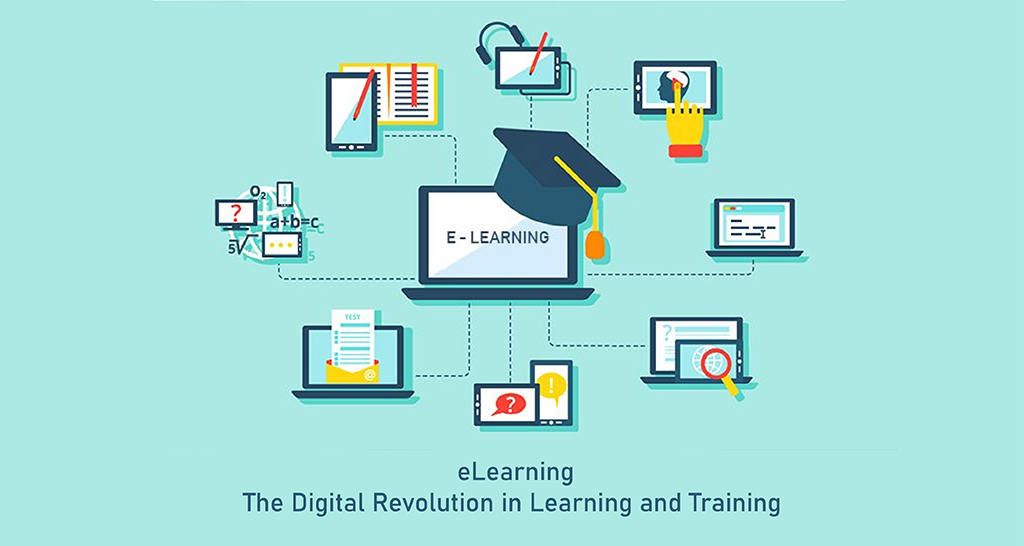The world of education and training has been rapidly transformed by digital technology, with eLearning leading the charge as the most popular way to deliver training today. Digital resources are used to provide learning and training through e-learning, also known as electronic learning. It is based on formalized education and provided through electronic devices like computers, tablets, and smartphones connected to the internet, making it a convenient and flexible method for acquiring knowledge and developing new skills.
In 1999, the term “eLearning” was coined by Elliott Maisie, which marked its introduction into professional terminology. Over time, the popularity of eLearning has surged, thanks in part to the internet’s rise and the availability of multimedia, affordable digital devices, and advanced learning management systems (LMS).
E-learning has transformed how people learn and train using electronic technologies to deliver educational content and training programs. This approach has gained popularity due to its flexibility, accessibility, and affordability compared to traditional classroom-based learning. With the integration of multimedia elements such as images, videos, audio, and graphics, eLearning provides more engaging and interactive learning experiences that keep learners interested and focused.
Digital devices have played a significant role in the growth of eLearning by making it more accessible to a broader audience. The affordability of devices has allowed learners to access course materials and learning resources from anywhere, at any time. The emergence of mobile learning has further facilitated this growth by enabling learners to access materials on their smartphones and tablets. The internet’s vast reach has made it possible for learners to access course materials and learning resources from anywhere in the world at any time, as long as they have an internet connection.
As eLearning continues to evolve, Learning Management Systems (LMSs) have become more advanced and now offer cloud-based solutions. Organizations utilize these systems to deliver various training programs, moving beyond traditional locally-installed systems. An LMS is a software application that allows organizations to manage, track, and provide training to employees or learners. There are many things to consider when choosing an LMS, but at a minimum, ensure it has the functionality and support you need to meet your learners’ objectives.
Interactive e-learning in social learning can take various forms, such as live webinars that include Q&A chats, virtual meetings, and discussions held on platforms like Zoom and Google Meet. Additionally, digital educational materials like podcasts, blogs, and eBooks also serve as interactive experiences that promote engagement, knowledge sharing, and learning.
When it comes to e-learning, there are two main types: Asynchronous and Synchronous.
Asynchronous e-learning is self-paced and allows learners to take the course independently, typically using a laptop or computer. This type of e-learning often includes pre-recorded lecture content and other interactive elements such as knowledge quizzes, simulations, and games.
On the other hand, Synchronous e-learning, also known as live-online training, involves real-time participation in instructor-led sessions regardless of location. It uses web-conferencing or virtual classroom platforms that enable interactive features such as chat, polling, and screen sharing, promoting a more collaborative learning experience.
Some e-learning tools are given below:
- iSpring Suite: The software suite is designed for creating eLearning courses and quizzes, with various tools like PowerPoint add-in, eLearning authoring, and quiz maker, along with support for interactive elements such as video, audio, and simulations.
- Adobe Captivate: This is another eLearning authoring tool that enables users to create engaging and interactive courses, quizzes, simulations, and assessments with multimedia integration. It also allows for integrating multimedia elements such as video and audio.
- Camtasia: This is a Screen recording and video editing tool for creating eLearning content such as tutorials and simulations. It provides editing tools and effects and supports multimedia addition.
- Docebo: This learning management system (LMS) is designed to manage and deliver eLearning courses. It provides various tools for course creation and management and tracking and reporting on learner progress and performance.
- Google Classroom: This is a free web-based platform that allows educators to create and manage online classrooms, where they can share course materials, assign tasks and quizzes, and communicate with learners.
- Zoom: This video conferencing tool is used for live online classes and webinars, supporting screen sharing, recording, and real-time collaboration among learners and instructors, as well as integration with whiteboards and polling.
Advantages of e-learning:
- One of the most significant advantages of e-learning is that it allows learners to study at their own pace and schedule. This is particularly useful for people who have busy work schedules or family commitments, as they can fit their learning around their other responsibilities. E-learning also eliminates commuting to a physical location, saving learners time and money.
- Another critical advantage of e-learning is its accessibility. With the rise of mobile devices, learners can access educational content anywhere. This means that people living in remote areas or those with limited mobility can still access high-quality educational resources. Additionally, e-learning can be customized to suit the individual needs of each learner, allowing them to focus on the areas they need to improve in and skip over material they already know.
- E-learning is also typically more affordable than traditional classroom-based learning. With no need for physical classrooms, textbooks, or other materials, e-learning programs can be offered at a lower cost to learners. This makes education more accessible to people from all socio-economic backgrounds.
Problems to be faced while using e-learning:
Of course, e-learning has its challenges.
- One of the most significant issues is ensuring learners stay engaged and motivated throughout the learning process. Without face-to-face interaction with instructors and peers, learners may struggle to stay motivated and may be more likely to drop out. To address this, many e-learning programs incorporate interactive elements such as quizzes, games, and social learning platforms to keep learners engaged.
- Another challenge of e-learning is ensuring learners access high-quality resources and support. This can be particularly challenging for learners in developing countries or those with limited internet connectivity. Ensuring learners have access to reliable internet and technical support can help address these issues.
Despite these challenges, the popularity of e-learning continues to grow due to its flexibility, accessibility, and affordability, and it is expected to become more prevalent as technology advances.
In conclusion, eLearning has revolutionized how we learn and train, providing learners with the flexibility and convenience to access learning materials from anywhere in the world at any time. The internet has facilitated the rise of eLearning, the development of multimedia, affordable digital devices, and well-built LMSs. Organizations that embrace eLearning can benefit from increased engagement, improved learning outcomes, and reduced costs.










